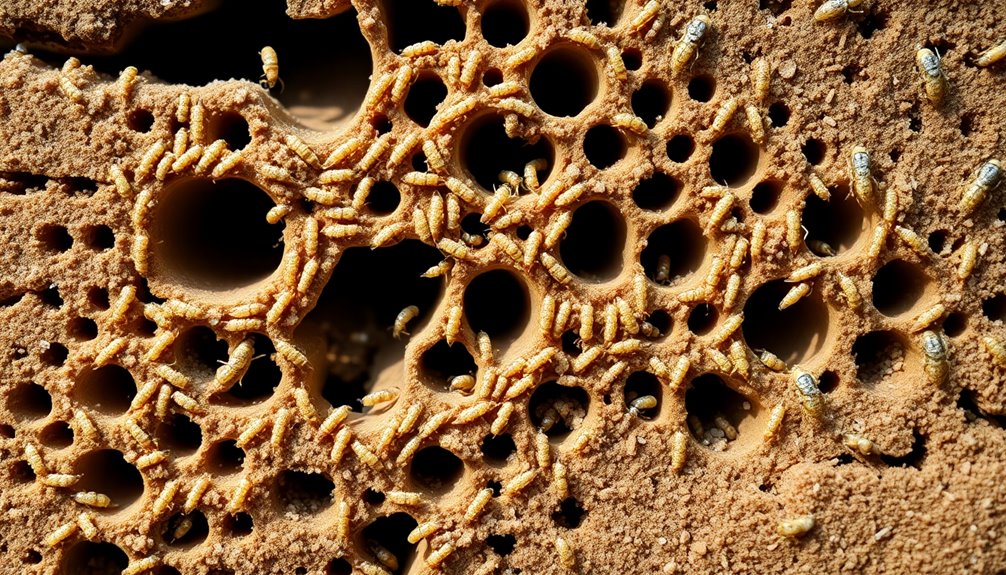Your soil’s pH level plays a vital role in how well nutrients are available to your edible plants. If the pH is too acidic or alkaline, certain nutrients become locked out, leading to nutrient deficiencies and stunted growth. Adjusting the substrate’s pH guarantees your plants can absorb essential nutrients like phosphorus, magnesium, iron, and manganese. Getting your soil pH right creates the ideal environment for healthy, thriving edibles—keep exploring to learn how to fine-tune it effectively.
Key Takeaways
- Substrate pH directly affects nutrient solubility and availability to edible plants.
- Proper pH adjustment in substrate prevents nutrient lockout, promoting healthier growth.
- Acidic substrates hinder magnesium and phosphorus uptake essential for edible plant development.
- Alkaline substrates can cause iron and manganese deficiencies, reducing edible crop quality.
- Monitoring and modifying substrate pH optimizes nutrient uptake for better edible plant yields.

Have you ever wondered why some plants thrive while others struggle in the same soil? The secret often lies beneath the surface—specifically, in the soil’s pH level and how it influences nutrient availability. When you understand how to manipulate these factors, you gain the power to *release* your plants’ full potential, creating an environment where they can flourish without constraints. Soil pH acts as a gatekeeper, controlling which nutrients are accessible to your plants. If the pH is too acidic or too alkaline, essential nutrients become *locked* away, leaving your plants malnourished and weak. To take control, you need to master pH adjustment techniques that allow you to create the perfect balance, tailoring the soil to meet your plants’ unique needs. Adjusting pH isn’t just about making the soil less acidic or more alkaline; it’s about *maximizing* nutrient availability. For example, in overly acidic soils, nutrients like phosphorus and magnesium become less available, which stunts growth. Conversely, in alkaline soils, iron and manganese can become unavailable, leading to deficiencies that hinder development. You, as a gardener or grower, can use simple yet effective pH adjustment techniques to correct these imbalances. Adding lime raises pH levels, making the soil less acidic, while sulfur or peat moss can lower pH, increasing acidity. These adjustments aren’t just guesswork—they’re strategic moves designed to liberate your plants from nutrient lockout. Additionally, understanding the role of contrast ratio can help you optimize your soil conditions for the best visual and growth results.
Frequently Asked Questions
How Does Soil Composition Affect Nutrient Availability for Edibles?
Your soil composition directly impacts nutrient availability for your edibles. Rich, well-balanced soil provides essential soil nutrients, fueling vibrant growth and robust root health. When your soil lacks key elements or is imbalanced, nutrients become scarce or locked away, stunting your plants. By understanding and improving your soil’s makeup, you guarantee your edibles thrive with healthy roots and abundant nutrients, giving you the freedom to grow lush, powerful plants.
Can Ph Levels Influence Pest Resistance in Edible Plants?
Yes, pH levels can influence pest resistance in edible plants. When you adjust soil acidity, you create an environment less inviting for pests, making your plants naturally more resilient. By controlling soil pH, you empower your garden to fight off unwanted invaders without chemicals. This approach gives you the liberation to cultivate healthy, pest-resistant edibles, aligning with your desire for a natural, sustainable growing experience.
What Are the Best Soil Amendments for Ph Adjustment?
Think of your soil as a battleground where you fight for healthy plants. To tip the scales, use lime amendments to raise pH or sulfur amendments to lower it. Lime acts like a shield, boosting alkalinity, while sulfur works like a secret weapon for acidity. You hold the power to liberate your edibles from imbalance, creating the perfect environment for growth and flavor to flourish.
How Often Should Soil Ph Be Tested for Optimal Growth?
You should test your soil pH at least once every 4 to 6 weeks to stay ahead of pH fluctuation and guarantee ideal growth. Regular testing frequency keeps you in control, allowing you to adjust amendments as needed. Don’t wait for issues to arise—monitor your soil consistently so your plants thrive and your garden remains vibrant. This proactive approach gives you the freedom to cultivate with confidence and precision.
Does Soil Type Impact the Flavor Profile of Edible Crops?
Yes, soil type impacts the flavor profile of your edibles. The soil texture influences nutrient availability, which shapes flavor nuances in your crops. Loamy soils tend to produce richer, more complex flavors, while sandy or clayey soils can lead to subtler tastes. By choosing the right soil, you *unleash* the full potential of your plants’ flavor, giving you the power to craft unique, liberated edibles that reflect your culinary freedom and personal style.
Conclusion
Remember, the right soil and pH level are your garden’s secret weapon—think of it like a trusty sword in your medieval arsenal. When you tailor your substrate, your edibles will thrive like noble knights on a quest. Don’t forget to check those levels regularly; neglecting them is like sailing without a compass. With a little effort, you’ll cultivate a bountiful harvest, proving that even in modern times, good dirt and proper pH still reign supreme.









